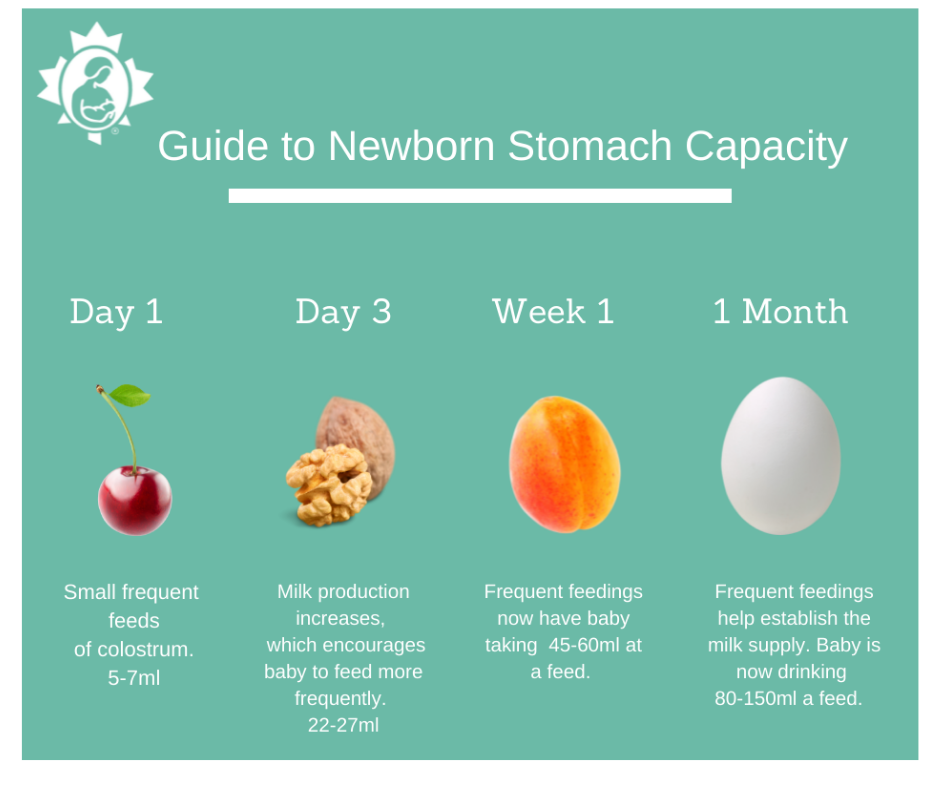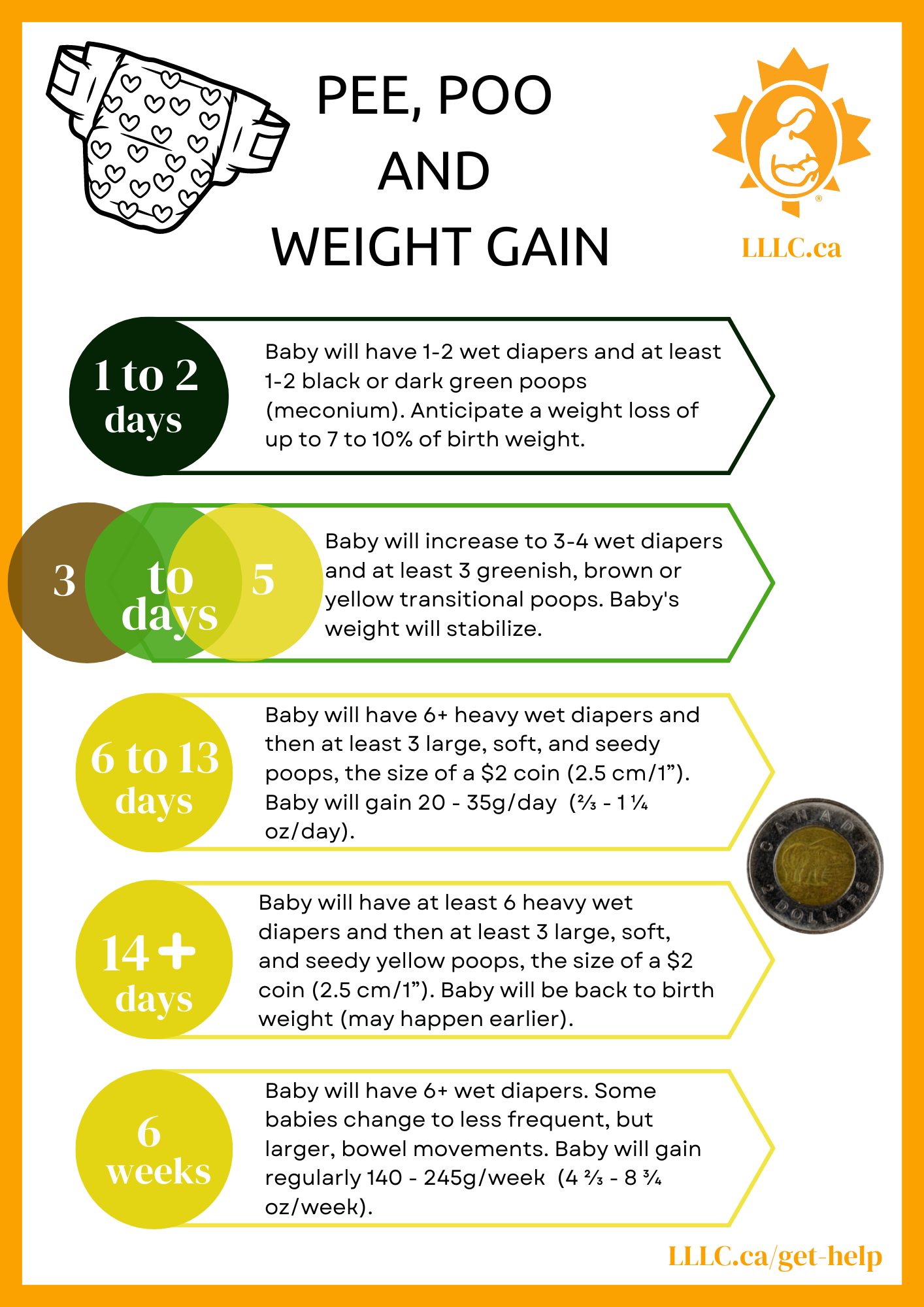Wet Diapers: Your baby may have only one or two wet diapers per day during the first or second day after birth. This will increase over the next 2-3 days. After day 4 a baby should have at least four really wet diapers per day (more if you use cloth diapers). By day 6 your baby should have at least six heavy wet diapers per day.
Bowel Movements: Babies pass meconium, the greenish-black, tarry first stool, over the first day or two. By the third day, the colour changes to a greenish transitional stool. By the fifth day, babies begin having at least three bowel movements per day, each at least the size of a $2 coin (2.5 cm). The stools will typically be very loose and bright yellow in colour, often with a seedy appearance. After five weeks of age, babies may tend to have less frequent but larger bowel movements.
Baby’s Weight: When breastfeeding is going well, a baby loses between 5% to 7% of birth weight during the first three or four days. Babies born by cesarean birth usually lose more weight compared to babies born vaginally. Also, babies born by mothers who received IV fluids within the final two hours before birth lose more weight, on average, than babies of mothers who do not receive such fluids. A weight loss of 8% to 10% may be fine for some babies. However, it is recommended that mother and baby be seen by a healthcare provider to evaluate the breastfeeding.
Once your milk supply becomes more plentiful, usually on the third or fourth day, expect your baby to begin gaining weight. Babies should regain their birth weights by the time they are 10 to 14 days old. After that, most breastfed babies gain an average of five to eight ounces (200 grams) per week or one-and-a-half to two pounds (900 grams) a month for the first four months. The weight gains suggested here are averages; some babies who are feeding well will gain more, some less. If your baby is gaining less than the average, you can discuss ways to increase milk intake with a La Leche League (LLL) Leader or International Board Certified Lactation Consultant (IBCLC). Either can offer suggestions to improve the latch and/or increase your milk supply. Before considering supplementation, you may want to have your baby evaluated for a possible tongue tie. A tongue tie, or tight frenulum, can restrict the baby’s tongue movement and make it harder to get enough milk.
Frequent Feedings: Babies breastfeed frequently, often every one-and-a-half to three hours. Feeds are timed from the start of one feed to the start of the next. Typically babies have an average of eight to twelve feeds in 24 hours. Frequent breastfeeding in the early days helps to establish your milk supply. Baby may feed for a shorter time on the first side and longer on the second or the other way around. Even if your baby seems finished, it is important to offer both breasts at each feeding.
Babies have their own feeding patterns. Some feed at regular intervals. Others feed very irregularly. Some babies cluster feed. This means they nurse very often for a few hours and then sleep for several hours. A good milk supply is established by following your baby’s feeding cues, not scheduling feedings. Cues may include licking lips, restlessness, rooting (turning head towards breast) or mouthing hands. Crying is a late hunger cue.
Signs that Baby is Drinking
By day 3 or 4 your breasts are often full of milk. After several seconds of rapid sucking, your milk will start flowing. At this time you may be able to hear regular swallowing. However, many mothers don’t hear swallowing at all. Often parents can hear a “kah” sound, or a puff of air, when their baby breathes out after swallowing. You can also look at your baby’s chin for signs of drinking. A baby’s chin moves up and down when sucking. When your baby is drinking a mouthful of milk the chin will drop for a longer “pause” while swallowing. Often babies rest for a couple of seconds before continuing a pattern of "sucks - dropped jaw - pause. If your baby drinks a lot of milk, you will notice that your breast feels softer or less full. See Positioning and Latching.
Parents sometimes think they do not have enough milk for their babies, or they think that their babies are not getting enough milk. You can carefully watch your baby’s feeding patterns and behaviour to ensure your baby is feeding effectively and getting enough milk. It’s important to know the signs that your baby is getting plenty to drink. See Low Milk Production for more information.
By day 6:
- Baby is gaining weight.
- Baby has at least 6 wet diapers in 24 hours.
- Baby has 3-5 stools in 24 hours.
- Stools are at least the size of a $2 coin.
- Baby is alert and active when not sleeping.
- Breasts feel softer after a feeding.
- Milk is leaking from one breast while your baby is feeding on the other.
Some common false alarms:
- Breasts suddenly appear to be soft. This frequently happens once the initial feeling of fullness subsides. It does not mean you are producing insufficient milk; it simply means that your production has adjusted to your baby’s needs.
- Breasts no longer leak between feedings. This is another sign that your milk supply is in tune with your baby’s needs. Some mothers continue to leak even after the early months; others seldom leak. Leaking is not related to how much milk you are producing.
- Your baby seems fussy. Many babies have a fussy time every day that is not related to hunger. You will learn what works to comfort your baby. Some babies need lots of stimulation and activity. Others need soothing and gentleness. If your fussy baby settles down when you offer him the breast, it is a sign that he is comforted by nursing, rather than not getting enough to eat. Breastfeeding each time your baby cues helps meet the baby’s needs and maintains a good milk supply.
- Your baby suddenly wants to nurse more often or seems hungry again soon after being fed. Babies go through several “growth spurts” during the first three months (at approximately 3 weeks, 6 weeks and 3 months of age). At these times they seem to want to nurse all the time for a few days. This is one way babies increase mothers’ milk supplies to meet their needs see Growth Spurts and Frequent Feeding Days.
- The time your baby spends nursing suddenly decreases, perhaps down to five minutes or so at each breast. As babies get older, they can become very efficient at removing milk. This is a positive sign that breastfeeding is going well, as long as your baby is gaining weight in the expected range.
Occasionally, because of health problems or other complications, a baby does not show all the signs of appropriate weight gain. If you have concerns about your milk supply or how your baby is doing, seek out help. Parents often notice subtle changes that others may not. La Leche League Canada Leaders can provide you with the information, support and encouragement you need to meet your infant feeding goals. Find out more at www.LLLC.ca
If your baby is gaining slowly, have a doctor, midwife or nurse check your baby for health issues. They can observe baby feeding at breast and make suggestions. Or they may refer you to an IBCLC for a lactation consultation. Your baby may need to be weighed frequently to see if the suggestions help.


